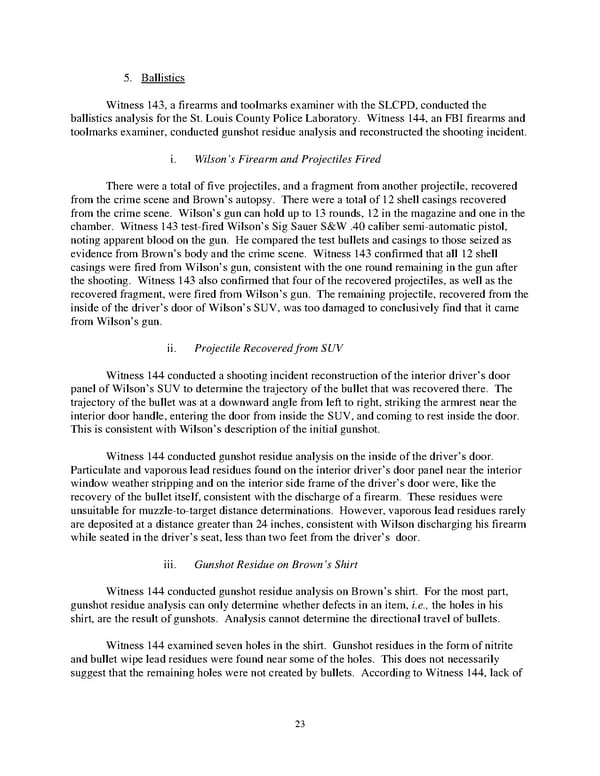5. Ballistics Witness 143, a firearms and toolmarks examiner with the SLCPD, conducted the ballistics analysis for the St. Louis County Police Laboratory. Witness 144, an FBI firearms and toolmarks examiner, conducted gunshot residue analysis and reconstructed the shooting incident. i. Wilson’s Firearm and Projectiles Fired There were a total of five projectiles, and a fragment from another projectile, recovered from the crime scene and Brown’s autopsy. There were a total of 12 shell casings recovered from the crime scene. Wilson’s gun can hold up to 13 rounds, 12 in the magazine and one in the chamber. Witness 143 testfired Wilson’s Sig Sauer S&W .40 caliber semiautomatic pistol, noting apparent blood on the gun. He compared the test bullets and casings to those seized as evidence from Brown’s body and the crime scene. Witness 143 confirmed that all 12 shell casings were fired from Wilson’s gun, consistent with the one round remaining in the gun after the shooting. Witness 143 also confirmed that four of the recovered projectiles, as well as the recovered fragment, were fired from Wilson’s gun. The remaining projectile, recovered from the inside of the driver’s door of Wilson’s SUV, was too damaged to conclusively find that it came from Wilson’s gun. ii. Projectile Recovered from SUV Witness 144 conducted a shooting incident reconstruction of the interior driver’s door panel of Wilson’s SUV to determine the trajectory of the bullet that was recovered there. The trajectory of the bullet was at a downward angle from left to right, striking the armrest near the interior door handle, entering the door from inside the SUV, and coming to rest inside the door. This is consistent with Wilson’s description of the initial gunshot. Witness 144 conducted gunshot residue analysis on the inside of the driver’s door. Particulate and vaporous lead residues found on the interior driver’s door panel near the interior window weather stripping and on the interior side frame of the driver’s door were, like the recovery of the bullet itself, consistent with the discharge of a firearm. These residues were unsuitable for muzzletotarget distance determinations. However, vaporous lead residues rarely are deposited at a distance greater than 24 inches, consistent with Wilson discharging his firearm while seated in the driver’s seat, less than two feet from the driver’s door. iii. Gunshot Residue on Brown’s Shirt Witness 144 conducted gunshot residue analysis on Brown’s shirt. For the most part, gunshot residue analysis can only determine whether defects in an item, i.e., the holes in his shirt, are the result of gunshots. Analysis cannot determine the directional travel of bullets. Witness 144 examined seven holes in the shirt. Gunshot residues in the form of nitrite and bullet wipe lead residues were found near some of the holes. This does not necessarily suggest that the remaining holes were not created by bullets. According to Witness 144, lack of 23
 DOJ Report on Shooting of Michael Brown Page 22 Page 24
DOJ Report on Shooting of Michael Brown Page 22 Page 24